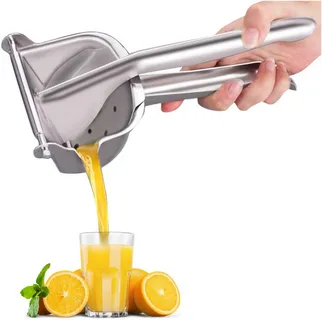Are you tired of flimsy juicers that buckle under pressure, leaving you with a kitchen mess and half the juice? It’s time to elevate your juicing game! Enter the stainless steel juicer—an investment that promises durability, style, and efficiency. Imagine effortlessly extracting every drop of goodness from your favourite fruits and veggies while adding a sleek, modern touch to your kitchen aesthetic. In this blog post, we’ll explore why opting for a stainless steel juicer isn’t just a choice; it’s an ultimate upgrade for health enthusiasts and culinary adventurers alike.
Introduction to juicing and its benefits
Juicing has taken the health world by storm, and for good reason. It is a fantastic way to pack your diet with essential vitamins, minerals, and antioxidants. Whether you’re looking to boost your energy levels or enjoy a refreshing drink, juicing can be an integral part of a healthy lifestyle. But before you dive into this vibrant world of fruits and vegetables, one crucial decision is choosing the right juicer.
With so many options available, it’s easy to feel overwhelmed. However, investing in a high-quality juicer can make all the difference in achieving delicious results while reaping maximum benefits from your produce. Among various choices on the market today, stainless steel juicers are exceptional kitchen companions that offer style and substance. If you’re serious about making fresh juice at home regularly, read on to discover why opting for a stainless steel model may be the best investment you’ll ever make for your kitchen!
Importance of choosing the right juicer for your needs
Selecting the right juicer is essential for maximizing your juicing experience. Various types are available, so it’s crucial to consider what best suits your lifestyle.
Are you a daily juice drinker or someone who enjoys an occasional glass? Your frequency will dictate whether you need a heavy-duty model or something more compact.
Think about the fruits and vegetables you’d like to juice. Some juicers handle leafy greens better than others, while specific models excel with more challenging produce like carrots and beets.
Ease of use matters, too. A complicated assembly can turn a refreshing morning ritual into a frustrating task. Look for features that align with your preferences—like easy cleanup or noise levels—to ensure you’ll enjoy using it regularly.
Ultimately, investing time in choosing the right juicer makes all the difference in reaping health benefits and enjoying delicious flavours at home.
Benefits of a stainless steel juicer over other types
There are various options available when purchasing a juicer for your kitchen. Different types of juicers claim to be efficient and durable, from plastic to glass and even ceramic. However, one type of juicer that stands out is the stainless steel juicer. This section will discuss the benefits of choosing a stainless steel juicer over other types.
1. Durability and Longevity:
Stainless steel is known for its strength and durability. Durability is an essential factor when it comes to kitchen appliances like a juicer, which requires frequent use. Stainless steel juicers are built to last for years without any wear or tear. They can withstand heavy usage without getting damaged easily, making them a long-term investment for your kitchen.
2. Easy Maintenance:
Compared to other types of juicers, stainless steel juicers are relatively easy to maintain and clean. They do not stain or retain odours like plastic or glass, making them hygienic for food use. Additionally, they can be easily cleaned with soap and water without worrying about rusting or discolouration.
3. Retains Nutritional Value:
One of the most significant advantages of using a stainless steel juicer is that it retains the nutritional value of fruits and vegetables during extraction. The material does not react with acidic juices, ensuring that all enzymes, vitamins, minerals, and nutrients remain intact in your juice.
4. Efficient Juice Extraction:
Stainless steel juicers have sharp blades that efficiently extract juice from fruits and vegetables, compared to other materials like plastic or glass, which may have dull blades over time due to wear and tear. A stainless steel juicer ensures maximum juice yield with minimal wastage.
Investing in a stainless steel juicer is a wise decision for your kitchen. Its durability, easy maintenance, retention of nutritional value, efficient juice extraction, and multi-functionality make it the ultimate choice over other types of juicers. With proper care and usage, a stainless steel juicer will continue serving you fresh and healthy juices for years.
Durability and longevity of stainless steel juicers
Stainless steel juicers stand out for their remarkable durability. Unlike plastic options, they resist scratches and dents, meaning your investment retains its sleek appearance over time. These juicers can handle the rigours of daily use without faltering. They’re built to withstand heavy fruits and vegetables, ensuring you won’t have to worry about wear and tear quickly.
Another key factor is longevity. A high-quality stainless steel juicer often lasts years longer than its counterparts made from less resilient materials.
This longevity translates into significant savings in the long run. You won’t need to replace it frequently, making it a wise addition to your kitchen arsenal. The robust nature of stainless steel also means fewer maintenance worries. You can focus on creating delicious juices rather than dealing with frequent repairs or replacements that other materials may require.
How stainless steel affects the quality of juice
Stainless steel is a popular material used in manufacturing kitchen appliances and utensils, including juicers. But how exactly does stainless steel affect the quality of juice? In this section, we will explore how this durable and versatile metal can impact your freshly squeezed juices’ taste, nutrition, and overall quality.
1. Non-Reactive Properties
One key reason stainless steel is preferred for juicers is its non-reactive properties. When fruits and vegetables are squeezed or blended, their acidic juices can react with certain metals, such as aluminium or copper, resulting in a metallic taste or discolouration. On the other hand, stainless steel does not react with food substances and preserves your juice’s natural flavour and colour.
2. Hygienic Material
Stainless steel is known for its hygienic properties due to its smooth surface, which prevents bacteria build-up. This makes it an ideal material for juicers as it ensures your juice remains free from harmful microorganisms. Additionally, stainless steel is easy to clean and maintain, eliminating potential cross-contamination between juices.
3. Durable and Long-Lasting
A high-quality stainless steel juicer can be a significant investment but one that pays off in the long run. Unlike plastic or glass juicers, which may crack or break easily, stainless steel is incredibly durable and resistant to wear and tear. It can withstand high pressure and frequent use without losing shape or functionality.
4. No Chemical Leaching
Some materials used in kitchen appliances may contain chemicals that can leach into your food during preparation or storage. Stainless steel does not have this issue as it is made up of natural elements like iron, chromium, and nickel, which do not leach into food substances when they come into contact with them.
5. Retains Nutritional Value
Stainless steel is the top choice when extracting juice from fruits and vegetables while preserving their nutritional value. The sharp blades and powerful motors of stainless steel juicers ensure that the juice is extracted efficiently without damaging the nutrients present in the produce. Additionally, since stainless steel does not heat up quickly, it prevents any loss of heat-sensitive vitamins and enzymes during the juicing process.
Easy maintenance and cleaning tips for stainless steel juicers
Cleaning a stainless steel juicer is straightforward, making it a joy to use. Start by disassembling the parts immediately after juicing. This prevents the pulp from drying and sticking. Rinse all removable components with warm water. A gentle sponge works wonders for removing any residue without scratching the surface.
For tougher stains or leftover pulp, mix baking soda and water to form a paste. Apply this mixture to stubborn spots, letting it sit briefly before rinsing thoroughly.
Don’t forget about the motor base! If needed, wipe it down with a damp cloth and mild soap—never submerge it in water. Lastly, air-dry your juicer completely before reassembling or storing it. This simple routine ensures your juicer remains in top shape for years while helping you enjoy fresh juice daily with minimal fuss.
Comparing the cost of a stainless steel juicer to other options
When considering a juicer, cost is often a significant factor. Stainless steel juicer typically sits at the higher end of the price spectrum. However, this investment pays off in multiple ways.
Plastic or lower-grade metal options may seem cheaper upfront but can falter in performance and lifespan. They often require replacements sooner than you’d like, ultimately costing more. Stainless steel models boast durability that withstands daily use without showing wear and tear. They also maintain their appearance while resisting rust and corrosion.
Stainless steel also saves money on maintenance, as many components are dishwasher-safe. This reduces cleaning time and effort compared to other materials that need special care. Regarding health benefits, investing in quality equipment ensures you’re extracting pure juice without harmful chemicals leaching into your drink from inferior materials.
Recipes to try with a stainless steel juicer
A stainless steel juicer opens up a world of refreshing possibilities. Start your day with a vibrant green juice. Combine kale, cucumber, and apple for a nutrient-packed boost.
For something zesty, try a citrus medley. Squeeze oranges, grapefruits, and lemons together for a tangy delight that energizes your morning routine. Feeling adventurous? Whip up a beetroot and ginger juice. The earthy sweetness of beets paired with the spicy zing of ginger creates a refreshing drink that’s as good for you as delicious.
Remember to experiment with combinations! Pineapple and mint make an exotic blend perfect for summer sipping. You can also create healthy smoothies using leftover pulp from your juicing sessions. Blend it into yogurt or oatmeal to enjoy added fibre in your breakfast bowls or snacks throughout the day.
Conclusion
Investing in a stainless steel juicer is wise for anyone committed to healthy living. The benefits are clear: durability, longevity, and superior juice quality set these juicers apart. Unlike plastic models that can easily warp or scratch, stainless steel retains its shape and finish even after years of frequent use. This means you can enjoy fresh juices without worrying about contaminants leaching into your drinks. The maintenance is hassle-free, too. A quick rinse after each use is usually all it takes to keep your juicer pristine, allowing you more time to focus on enjoying your beverages rather than cleaning up.
FAQs
1. How do I clean a stainless steel juicer?
Cleaning a stainless steel juicer is simple and easy. First, unplug the juicer and disassemble all removable parts. Wash these parts with warm, soapy water and rinse them thoroughly. For tougher stains or residue, you can use a mixture of baking soda and water to scrub the parts gently. Make sure to dry all the parts completely before reassembling the juicer.
2. Can I put whole fruits or vegetables in a stainless steel juicer?
No, putting whole fruits or vegetables in a stainless steel juicer is not recommended, as this may damage the blades and motor of the machine. It is best to cut them into smaller pieces before putting them into the juicer for optimal results.
3. Is using a stainless steel juicer for leafy greens safe?
Yes, stainless steel juicers extract juice from leafy greens such as kale, spinach, and wheatgrass. The machine’s sharp blades ensure efficient extraction without damaging delicate leaves.



